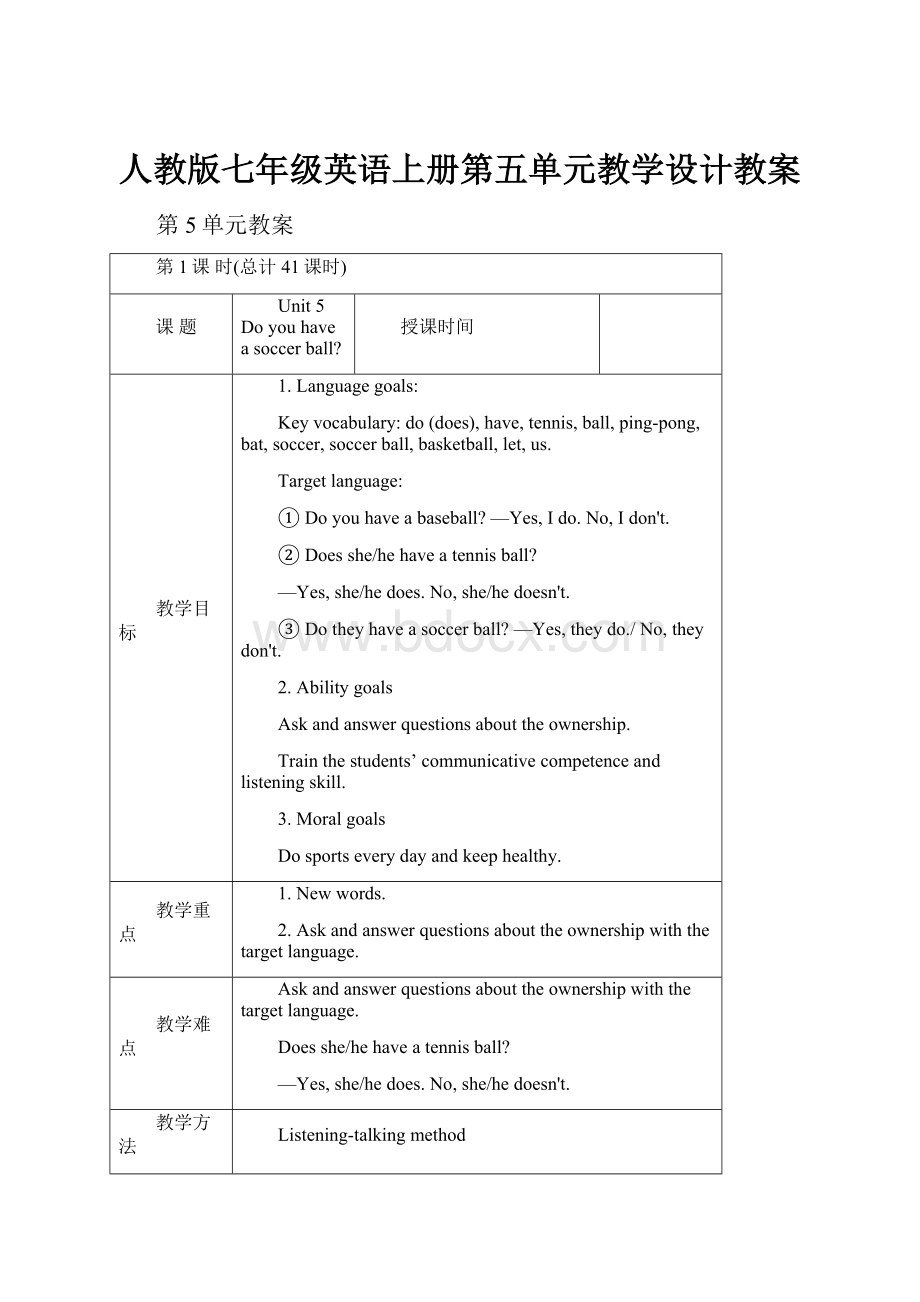人教版七年级英语上册第五单元教学设计教案.docx
《人教版七年级英语上册第五单元教学设计教案.docx》由会员分享,可在线阅读,更多相关《人教版七年级英语上册第五单元教学设计教案.docx(25页珍藏版)》请在冰豆网上搜索。

人教版七年级英语上册第五单元教学设计教案
第5单元教案
第1课时(总计41课时)
课题
Unit5Doyouhaveasoccerball?
授课时间
教学目标
1.Languagegoals:
Keyvocabulary:
do(does),have,tennis,ball,ping-pong,bat,soccer,soccerball,basketball,let,us.
Targetlanguage:
①Doyouhaveabaseball?
—Yes,Ido.No,Idon't.
②Doesshe/hehaveatennisball?
—Yes,she/hedoes.No,she/hedoesn't.
③Dotheyhaveasoccerball?
—Yes,theydo./No,theydon't.
2.Abilitygoals
Askandanswerquestionsabouttheownership.
Trainthestudents’communicativecompetenceandlisteningskill.
3.Moralgoals
Dosportseverydayandkeephealthy.
教学重点
1.Newwords.
2.Askandanswerquestionsabouttheownershipwiththetargetlanguage.
教学难点
Askandanswerquestionsabouttheownershipwiththetargetlanguage.
Doesshe/hehaveatennisball?
—Yes,she/hedoes.No,she/hedoesn't.
教学方法
Listening-talkingmethod
教学准备
Textppt
教学过程及内容
二次备课
Step1.Warming-up
1.Watchaflash:
Let’sPlayoutdoors.
T:
Intheflash,wecanseetwokindsofballs,whatballscanyousee?
(learnthenewwords:
letusplay;go).
Step2.Newwordspresentation.
1.Presentthekeyvocabulary.Showthepicturesortheballs.
(Showasoccerballtotheclass.)
T:
What’sthisinEnglish?
S1:
It’sasoccerball.
T:
Yes,youareright.Readafterme.
Thensay:
Let’splaysoccer.—playsoccer.
(Showthestudentsotherobjectsorpictures.Teachthenewwords“basketball,ping-pongball,volleyball,tennisbat,ping-pongbat”inthesameway.)
T:
Readthewordstogethertwice.
2.Trytorememberthewordsbyreading.
3.Playagame:
Whohasbesteyes.
Step3Workon1a
1.T:
Whatcanyouseeinthepicture?
Andask “Where is the..?
2.Lookatthewordsin1aandmatchthewordswiththethingsinthepicture.
T:
Number1is(a),tennisball.What’sNumber2Matchthem.
3.Askonestudenttoshowtheanswersandcheckthem.
Step4Presentthekeystructure1.
1.Presentthesequestionsandanswers.
(Pointtoastudentwhohasapencilbox.)
T:
Doyouhaveapencilbox?
S1:
Yes,Ido.(Nodyourheadyes)
T:
Doyouhaveabasketball?
S1:
Yes,Ido.Ihaveabasketball.
T:
Doyouhaveaping-pongbat?
S1:
No,Idon’t.Idon’thaveaping-pongbat.
2.Writethesentencesontheblackboard.
Practicethedrill“Doyouhavea…?
”inpairs.
Lookatthemodel,thenpracticelikethis.
Model:
S1:
Doyouhaveabasketball?
S2:
Yes,Ido.Ihaveabasketball.
S1:
Doyouhaveasoccerball?
S1:
No,Idon’t.Idon’thaveasoccerball.
(Studentsworkinpairs.)
Step5.Workon1b:
Listening
T:
Lookatthefouritemsof1binthepictures.Listentotheconversation.
T:
Listentotheconversationandcirclethewordsyouhear.
(Playtherecording.)
T:
Checktheiranswers.
Step6.1cPairwork
1.Readtheconversationsin1c.(Askstudentstorepeat.)
2.Watchavideo.
3.Lookatthepicturein1aandpracticetheconversationwitheachotherinpairs.
S1:
Doyouhave…?
S2:
Yes,Ido.
S1:
Doyouhavea…?
S2:
No,Idon’t.
Step7Presentthekeystructure2.
Makeasurvey—Let’sask.
Pleaseaskyourclassmatesinthegroupwhatballshe/shehas.Thenwritedowntheinformationinthechart.Nowwhowantstodisplayyourprojectontheblackboard?
Sampleproject:
Names
Ballsyouhave
LiHong
ping–pongbat
YangQuan
soccerball
T:
DoesYangQuanhaveasoccerball?
No,hedoesn’t.Hedoesn'thaveasoccerball.
DoesLiHonghaveatennisball?
Ss:
No,shedoesn’t.Shedoesn’thaveatennisball.
T:
DoesLiHonghaveaping–pongbat?
Ss:
Yes,shedoes.Shehasaping-pongbat.
Writethesentencesontheblackboardandreadthem.
Practicelikethis.
Showthepictures,
T:
Dotheyhaveabasketball?
Yes,theydo.Theyhaveabasketball.
Dotheyhaveatennisball?
No,theydon’t.Theydon'thaveatennisball.
Summarize.I/We/you/they/theboys/AandB…do
he/she/it/Jane…does
Step8Workon2aand2b
1.T:
Lookatthepictures,dothepeoplehaveballs?
Let’slistentotheconversations.
2.Playtherecording.Finish2a.Thistimepleaselistenforthenamesinthepictures,andthennumberthepictures(1-4).
3.Afterthataskafewstudentstosayouttheiranswersin2a.
4.Playtherecordingforagain.
T:
Youaretomatchthepeoplefromactivity2atotheballsintherecordingthencorrecttheanswers.
T:
Youlistentothetapeandwritethenumbersfromthepicturesin2bnexttothecorrectballs.
5.Afterdoinglistening,asksomestudentstosayouttheiranswers.
6.Readthetapescript.
Step9.Pairwork,2c
1.Lookatthethingsinthepicture.Askyourpartnerifhe/shehasthethingsin2c.Let’slookatthepicturein2a.
T:
DoesJanehaveatennisball?
S1:
No,shedoesn't.
T:
DoesPaulhaveasoccerball?
S2:
No,hedoesn't.
T:
Doeshisbrotherhaveasoccerball?
S2:
Yes,hedoes.
(Askmorestudentstomakeaconversation.)
T:
Makeconversationswiththingsinthepicture.S:
…
2.Asksomepairstoactouttheirconversations.
3.Askthestudentstoactouttheconversationinpairswithotherthings.
Sampleconversations:
S1:
Doyouhave,Tom?
S2:
Yes,Ido.
S1:
Doyouhaveaneraser?
S2:
No,Idon’t.
S1:
DoesTomhaveadictionary?
S3:
Yes,hedoes.
S1:
DoesTomhaveaneraser?
S3:
No,hedoesn’t.
Step10Summarizeandexercises.
一.句型转换
Ihaveabaseball.(改为一般疑问句)
_____________abaseball?
2.Doeshehaveatennisball.(作肯定回答)
____,________.He____atennisball.
3.Theyhaveaping-pongbat.(改为否定句)
They_________aping-pongbat.
二.用所给单词的正确形式填空。
1.-__ you______(have)aping-pongbat?
-Yes,Ido.I____(have)aping-pongbat.
2.-_____she______(have)abasketball?
-Yes,she____(do).She___(have)abasketball.
3.-___they____(have)asoccerball?
-No,they____(donot).They____(donot)haveasoccerball.
课后反思
第2课时(总计42课时)
课题
Unit5Doyouhaveasoccerball?
授课时间
教学目标
1.Teachingaims:
Words:
does,doesn’t,let,us,let’s,play,late,sound,good,get,we,has,great.
targetlanguage:
Doyouhaveabaseball?
—Yes,Ido.No,Idon't.Ihaveavolleyball.
Doesshe/hehaveatennisball?
—Yes,she/hedoes.No,she/hedoesn't.She/Hehasabaseball.
Dotheyhaveabasketball?
—Yes,theydo./No,theydon't.Theyhaveavolleyball.
Let’splaybasketball.—Thatsoundsgood.
2.Abilitygoals:
Trainthestudents’communicativecompetenceEnablethestudentstomakesuggestionspolitely.
3.Moralgoals:
Trainthestudentstomakesuggestionspolitelyandtakeactivitypartinschoolsportsclubandkeephealthy.
教学重点
Grammarfocus.
教学难点
Grammarfocus.
教学方法
Listening-speadingingmethod
教学准备
教学过程及内容
二次备课
Step1.Revision:
achant:
Doyouhaveabasketball?
Yes,Ido.Yes,Ido.
DoesPaulhaveatennisball?
Yes,hedoes.Yes,hedoes.
DoesJanehaveavolleyball?
No,shedoesn’t.No,shedoesn’t.
Dotheyhaveabaseballbat?
No,theydon’t.No,theydon’t.
Step2Presentation
(Showasoccerballtoclass.)
T:
Let’splaysoccerballafterclass,OK?
S1:
OK.
T:
Let’splayping-pong.S2:
OK.
T:
Weoftenusethedrill“Let’s…”tomakeasuggestion.Ifyouwanttodoit,youmaysay“OK./Thatsoundsgood./Allright…”Ifyoudon’twanttodoit,youmaysay“No,Idon’thavea…”
(Theteacherwritesthedrillonthebackboard.)
A:
Let’splay…
B:
No,Idon’thavea…A:
Well,let’splaybaseball.
B:
OK.Let'sgo.
Step3Workon2dRole-play
1.CindyandHelenwanttoplaybaseball.Nowreadtheconversationandmatchthethingswiththeirrightplaces.
baseballonthechair
baseballbatinCindy'sbag
Cindy'sjacketBillhasit.
2.Readtheconversationaftertheteacher.
3.Practicetheconversationwithyourpartner.
4.Asksomepairstoactoutthedialogueinfrontoftheclass.
Step4GrammarFocus.
1.ReadGrammarFocus.
2.Makesentenceswithhave.(用have说句子)
I/We/You/Theyhavea...
(1).I/We/You/Theyhavehave…….是_______(疑问句/陈述句).意思是____________.
(2).句型是:
______+______+宾语。
3.用has说句子:
She/Hehasa……
(1.)He/Shehas……..是_________(疑问句/陈述句).是第____人称______(单数/复数)形式。
意思是_____________.
(2).基本句型:
______+______+宾语。
+
4.练一练:
用have/has填空
A.I____abaseball.B.She____abasketball.
C.John_____aping-pongbat.D.We____threebaseballbats.
E.Mymother____aring.
5.ReadGrammarFocusandfinishoffthesesentences.
①你有一个棒球吗?
____you_____abaseball?
②是的。
___,I____.不,没有。
_____,I______.
③你有一个乒乓拍吗?
____you_____aping-pong_____?
④没有。
我有个乒乓球。
___,I____.I___aping-pong____.
⑤他们有一个篮球吗?
___they_____abasketball?
⑥是的,有。
没有。
他们有一个排球
Yes,__________.____,they______.They______a________.
6.Doyouhave……?
是___________(一般疑问句/特殊疑问句)用来询问某人是否拥有某物。
是对第_____人称的提问,
肯定回答___________否定回答________________
7.Dotheyhave……?
用来询问____________。
是对第三人称的____(单数/复数)的提问。
肯定回答________否定回答____________
句型:
对某人是否拥有某物的提问的句型:
Do_____+______+宾语?
⑦她有一个网球吗?
____she_____atennis?
⑧是,她有。
没有。
她有一个棒球。
_____,she_________.____,she________.She____a______.
⑨他有一个足球吗?
_____he_____a_____ball?
⑩没有。
他有两个乒乓球拍。
____,he________.He____twoping-pong______.
8.Doeshe/she/have……?
是___________(一般疑问句/特殊疑问句)用来询问________________是对第_____人称的提问.
肯定回答_______________否定回答_______________
基本句型:
_______she/he+_______+宾语?
9.Summarize:
一般疑问句:
某人有某物吗?
表示谁拥有什么的时候,当主语是第一,二人称和第三人称复数时,动词用__________,当主语是第三人称单数时,动词用_______.
变一般疑问句时,第一,二人称和第三人称复数是在句首加_______,第三人称是在句首加_______,do和does后的动词have都使用_________(形式).
1)I_______atennisball._____you________atennisball?
2)They________aroom._____they______aroom?
3)Mike_______abasketball._____Tom_______abasketball?
10.写出下列表达方式的缩写形式
①donot=________②doesnot=______
③weare=______④letus=________.
Step5.Workon3a
1.指导:
英语句子中的人称和数
人称
汉语
主格
助动词